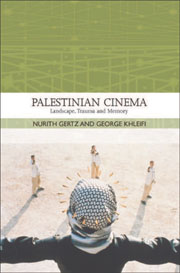Book contents
- Frontmatter
- Contents
- TRADITIONS IN WORLD CINEMA
- Dedication
- Introduction
- 1 A Chronicle of Palestinian Cinema
- 2 From Bleeding Memories to Fertile Memories
- 3 About Place and Time: The Films of Michel Khleifi
- 4 Without Place, Without Time: The Films of Rashid Masharawi
- 5 The House and its Destruction: The Films of Ali Nassar
- 6 A Dead-End: Roadblock Movies
- 7 Between Exile and Homeland: The Films of Elia Suleiman
- Conclusion
- Epilogue
- Bibliography
- Filmography
- Index
Conclusion
Published online by Cambridge University Press: 05 August 2013
- Frontmatter
- Contents
- TRADITIONS IN WORLD CINEMA
- Dedication
- Introduction
- 1 A Chronicle of Palestinian Cinema
- 2 From Bleeding Memories to Fertile Memories
- 3 About Place and Time: The Films of Michel Khleifi
- 4 Without Place, Without Time: The Films of Rashid Masharawi
- 5 The House and its Destruction: The Films of Ali Nassar
- 6 A Dead-End: Roadblock Movies
- 7 Between Exile and Homeland: The Films of Elia Suleiman
- Conclusion
- Epilogue
- Bibliography
- Filmography
- Index
Summary
In this book we have examined the place of the Palestinian people in history and the place of history in the Palestinian narrative. We have explored the connection between Palestinian history and Palestinian cinema, analyzing the manner in which cinema has constructed Palestinian memory and space, representing the places that once existed and those that are now gone. Also contemplated is the cinematic documentation of the lives of Palestinian men, women, and children, both within Israel and outside it, in the family, the village, and the refugee camp. We have traced the cinematic expression of the hardships of exile together with longing for the lost past and its return.
Palestinian cinema is a national cinema. Throughout its history, it has given form to a militant Palestinian nationalism, recounted Palestinian history, and sought the place and daily lives of ordinary Palestinians within that history. This delicate fabric of intertwined personal narrative and national history has been closely related to the national traumas.
In the early cinema, created in the 1970s under the auspices of the Palestinian organizations, the individual represented the national collective, its struggles, and its fate, which was perceived as stagnant and unchanging. The portrayal of the present, moreover, merely amounted to a reconstruction of the past – a restoration of the fixed structure of profound tranquility that had been disturbed by the sudden violence of 1948 and which is continuously reflected in each and every present event depicted.
- Type
- Chapter
- Information
- Palestinian CinemaLandscape, Trauma and Memory, pp. 190 - 192Publisher: Edinburgh University PressPrint publication year: 2008



